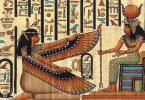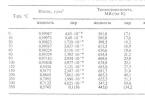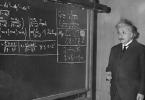To use presentation previews, create a Google account and log in to it: https://accounts.google.com
Slide captions:
Agnia Lvovna Barto was born into the family of veterinarian Lev Nikolaevich Volov in 1906.
Agnia Barto did not like to remember her childhood. The family led an intelligent life typical of those times: home-based primary education, French, formal dinners with pineapple for dessert.
Lev Nikolaevich, a fan of art, saw his daughter’s future in ballet. Agnia diligently practiced dancing, but did not show much talent in this activity. The early manifested creative energy was directed into another direction - poetry. She became interested in poetry, following her school friends.
In 1925, nineteen-year-old Agnia Barto published her first book, “The Chinese Little Wang Li.”
During the Great Patriotic War, Agnia Lvovna’s family settled in Sverdlovsk. She worked as a turner at a factory. In 1942 she went to the front as a front-line correspondent. Barto returned to the capital in 1944.
Agnia Lvovna dedicated many of her poems to her daughter Tatyana. And with the advent of her grandson, Volodya wrote a number of poems: “Vovka is a kind soul.”
A. Barto could often be seen among the guys. She visited schools, attended classes, and met her readers in children's libraries. Often coming to performances, Agnia Barto suggested: “Dear children, I will read only the first line, and you continue the rest.” There was never a time when the guys didn’t remember the poem.
A. Barto devoted her entire life to children's poetry and left us many wonderful poems.
On the topic: methodological developments, presentations and notes
Presentation of the biography of M.Yu. Lermontov
Presentation of the biography of M.Yu. Lermontov can be used in a literary reading lesson in grade 4 when studying this topic....
Presentation "Biography and creativity of the artist K.F. Yuon"
The multimedia presentation presents a brief biography of the artist and a selection of his paintings. The presentation can be used in Russian language lessons, literary reading, fine arts...
To use presentation previews, create a Google account and log in to it: https://accounts.google.com
Slide captions:
1906-1981 Agnia Lvovna Barto (Agniya Lvovna Volova) – writer, poet, film screenwriter. Born on February 17, 1906 in Moscow in the family of a veterinarian.
She studied at the gymnasium, where she began writing poetry. Agnia diligently practiced dancing, but did not show much talent in this activity. The early manifested creative energy was directed into another direction - poetry.
Agnia Volova's youth fell on the years of revolution and civil war. But somehow she managed to live in her own world, where ballet and poetry writing coexisted peacefully. However, the older Agnia became, the clearer it was that she would not become either a great ballerina or “the second Akhmatova.”
In 1925, books of poems for children were published - “The Chinese Little Wang Li”, “The Thief Bear”. A conversation with Mayakovsky about how children need fundamentally new poetry, what role it can play in the education of a future citizen, finally determined the choice of subject matter for Barto’s poetry.
In her early youth she married the poet Pavel Barto and gave birth to a son, Garik
At twenty-nine, she left her husband for the man who became the main love of her life. Agnia kept the surname Barto, but spent the rest of her life with energy scientist Shcheglyaev, with whom she gave birth to a second child, daughter Tatyana.
After the publication of the cycle of poetic miniatures for the little ones “Toys” (1936), as well as the poems “Flashlight”, “Mashenka” and others, Barto became one of the most famous and beloved children's poets by readers
Agnia Barto wrote the scripts for the films “The Foundling” (1940, jointly with actress Rina Zelena), “Alyosha Ptitsyn Develops Character” (1953), “10,000 Boys” (1962, jointly with I. Okada). Her poem “Rope” was taken by director I. Frez as the basis for the concept of the film “The Elephant and the Rope” (1945).
During the Great Patriotic War, Barto was evacuated in Sverdlovsk, went to the front to read her poems, spoke on the radio, and wrote for newspapers. Her poems of the war years (the collection “Teenagers”, 1943, the poem “Nikita”, 1945, etc.) are mainly journalistic in nature.
For the collection “Poems for Children” (1949) Agnia Barto was awarded the State Prize (1950).
Four days before the long-awaited Victory, a tragedy occurred in the poetess’s family - her son Igor was hit by a truck while riding a bicycle. The poems left the house. Agnia Lvovovna began visiting orphanages where orphans lived - victims of the war. There she again became convinced of how much children care about poetry. She read her poems to them and saw how the children began to smile.
The children of the orphanage are described in Barto’s poem “Zvenigorod” (1948) Children of warriors, fighters In this orphanage. Here are portraits of their fathers, Cards in an album. This is what a family is like here - daughters and sons here.
For nine years, Barto hosted the radio program “Find a Person,” in which she searched for people separated by the war. With its help, about 1,000 families were reunited.
We will not know which stories and for what reasons were not aired. But we can read those selected for the book “Find a Person,” written based on the materials of the program and first published in 1968 in the magazine “Znamya.”
In “Notes of a Children's Poet” (1976), the poetess formulated her poetic and human credo: “Children need the whole range of feelings that give rise to humanity.”
Agnia Lvovna loved her grandchildren Vladimir and Natalya very much, dedicated poems to them, and taught them to dance. She remained active for a long time, traveled a lot around the country, played tennis and danced on her 75th birthday.
Agnia Barto died in 1981, having not recovered from a heart attack, and barely having time to rejoice at the birth of her great-granddaughter Asya. The poetess is buried at the Novodevichy cemetery. A crater on Venus and a small planet near the orbit of Jupiter are named after her.
The presentation was prepared by the head. library MBOU "Secondary school No. 4" Chistopol Republic of Tatarstan Nikolaeva Elena Vladimirovna Thank you for your attention!
Agnia Lvovna Barto 1906-1981 Agnia Lvovna Barto
- writer
- screenwriter
- radio presenter
- Russian Soviet children's poetess
She received a good home education, led by her father.
She studied at the gymnasium, where she began writing poetry. At the same time, she studied at the choreographic school, where A. Lunacharsky came for graduation tests and, after listening to Barto’s poems, advised her to continue writing.
Agnia Lvovna devoted her entire life to children's poetry and left us many wonderful poems. Agnia Barto once said: “Almost every person has moments in life when he does more than he can.” In her case, it was not a minute - she lived her whole life this way.
Agnia Lvovna Barto passed away on April 1, 1981. She was buried in Moscow at the Novodevichy cemetery.
The name Agnia Barto was given to one of the minor planets (2279 Barto), located between the orbits of Mars and Jupiter.
The name Agnia Barto was given to one of the minor planets (2279 Barto), located between the orbits of Mars and Jupiter.
The name of Agnia Barto was given to one of the craters on Venus.
The name of Agnia Barto was given to one of the craters on Venus. 1906 - 1981

Read books by A.L. Barto The presentation was prepared by Petrova Marina Mikhailovna, a primary school teacher at GBOU secondary school No. 349 with in-depth study of the English language in the Krasnogvardeisky district of St. Petersburg
Agnia Lvovna Barto
There are books
who love

all the guys.
Among these books are poems by Agnia Barto.

Her father, Lev Nikolaevich Volov, was a veterinarian, and they always had many different animals in the house. My father's favorite writer was Leo Tolstoy. And as A. Barto recalled, her father taught her to read from his books. He also loved to read and knew by heart all the fables of I.A. Krylov. Everyone has a dream in childhood - Agnia dreamed of becoming an organ grinder: walking around the courtyards, turning the handle of the organ grinder, so that people attracted by the music would lean out of all the windows. Agnia studied at the gymnasium, where And started write
poetry.

At the same time she studied at a choreographic school. I dreamed of becoming a ballerina.

Agnia Lvovna devotes herself to her work with enthusiasm. She studies with Chukovsky and Marshak.
She regularly published collections of poems: “Brothers” (1928), “On the contrary boy” (1934), “Toys” (1936), “Bullfinch” (1939).

During the Great Patriotic War, Barto spoke a lot on the radio and went to the front as a newspaper correspondent.
In the post-war years, Agnia Lvovna became the organizer of a huge movement to search for families separated during the war. She suggested searching for lost parents using childhood memories. Through the “Find a Person” program on Mayak radio, it was possible to connect 927 separated families.
A. Barto raised children using humor.
◦ How great the impact of Agnia Barto’s cheerful poems on her readers can be judged by the following fact, for example, given in the Teacher’s Newspaper of April 6, 1976: “The boy underwent several operations. There was another one to come. The doctor said it would be good to endure it without anesthesia. And the boy agreed on the condition that during the operation the poems of Agnia Barto would be read to him.”



Resources:
www.youtube.com/watch?v=pt-b1a7YRPo
http://www.char.ru/books/164710
http://www.zone-x.ru/ShowTov.asp?Cat_Id=670082&partner=4
www.agniyabarto.ru/00_barto-100-semeynoe-schastie-aif.htm
http://www.setbook.ru/books/authors/author2276.html
Born on February 4 (17), 1906 in Moscow in the family of a veterinarian. Agnia began writing poetry as a child, but in the future she saw herself as a ballerina and even graduated from a choreographic school. In 1925 her first poems were published. Barto's extraordinary talent as a children's poet was noted by K. I. Chukovsky.

Agnia Barto was born in Moscow in 1906, died in 1981, lived 75 years. She was born into the family of veterinarian Lev Nikolaevich Volov, who instilled in her from a very early age a love of reading, of great Russian poets and writers. She began writing from childhood in elementary school. These were serious poems - about princes in love! And only later, when she got older, she wrote poems about her girlfriends. Since then, her poems have become distinguished by their accessibility, understandability, humor, as if expressing children's feelings. Barto's poems bring adults and children closer together, helping them communicate. She wrote not only poetry, but songs and various comedies for theater performances and films. After the war A.L. Barto hosted the program “Find a Person.” She managed to unite 927 families scattered throughout the world by the war. Then the book “Find a Person” and a film with the same name appeared. She turned 103 in February of this year. She has been gone for 28 years, but poets do not die, poems remain. So today, guys, I would like to introduce you to some of A.L.’s poems. Barto and remember those that you already know.





After the publication of the cycle of poetic miniatures for the little ones “Toys” (1936), as well as the poems “Flashlight”, “Mashenka”, etc. Barto became one of the most famous and beloved children's poets by readers, her works were published in huge editions, included in anthologies. The rhythm, rhymes, images and plots of these poems turned out to be close and understandable to millions of children.

In 1925, Barto's first works, children's books of poems "The Thief Bear" and "The Little Chinese Wang Li", were published.

During World War II, Barto often spoke on the radio in Moscow and Sverdlovsk, wrote war poems, articles, and essays. In 1942 she was a correspondent for Komsomolskaya Pravda on the Western Front.



In 1958 she wrote a large cycle of satirical poems for children “Leshenka, Leshenka”, “Grandfather’s Granddaughter”, etc.

For many years, Barto headed the Association of Children's Literature and Art Workers and was a member of the international Andersen jury. In 1976 she was awarded the International Prize. H.K. Andersen. Barto's poems have been translated into many languages of the world.





1. moos 2. sighs 3. jumps First round: Attention! Question What does the bull do when it walks and swings? Which of these works was not written by A. Barto? 1. horse 2. Nastenka 3. flint Of three objects - two are taken from the works of A. Barto, and one is not: A. Barto, and one is not: 1. airplane 2. ball 3. samovar sighs flint samovar samovar

What is the name of the poem that contains these lines: Time to sleep! The bull fell asleep and lay down on its side in the box. The sleepy bear went to bed, but the elephant doesn’t want to sleep. which contains these lines: Time to sleep! The bull fell asleep and lay down on its side in the box. The sleepy bear went to bed, but the elephant doesn’t want to sleep. First round: Attention! Question 1. bull 2. elephant 3. bear What word is in the poem “Bunny”? 1. friend 2. snow 3. bench What was the name of the girl in the work “The Helper” who was very tired while doing nothing? 1. Tanyusha 2. Lidochka 3. Nastenka elephant bench Tanyusha Tanyusha

First round: What could little Nastenka do while lying in a stroller? 1. cry 2. dance 3. smile Which poem ends with the words: “...And then we’ll go back to mom”? “...And then we’ll go back to mom”? 1. truck 2. plane 3. boat Why was Tanya crying? 1. fell 2. dropped the ball into the river 3. hit Attention! Question smile dropped a plane dropped a ball into a river

Second round: Attention! Question Attention! Question 1. horse 2. bunny 3. bull Name the numbers of animals that A. Barto wrote about in the “Toys” cycle: Name the numbers of vehicles, means that A. Barto wrote about in the “Toys” cycle: Name the number of toys , about which A. Barto wrote, in the “Toys” series: 1. truck 2. helicopter 3. boat 1. ball 2. pipe 3. doll

Third round: Attention! Question Attention! Question 1. Wolves 2. Robbers 3. Bears It was in January, there was a Christmas tree on the mountain, And evil people were wandering around this tree... I can’t come to an agreement with Nastya at all! I tell her: “Hello!”, and she “...”. “Hello!”, and she “...”. And in the north, where there is snow, where the frosts are severe, the boys got up earlier in the morning - .... 1. Hello 2. Agu 3. Hello 1. Tungus 2. Nenets 3. Yakuts Wolves Agu Yakuts Yakuts

Third round: Attention! Question Attention! Question 1. acid 2. vinegar 3. tea We look at the boy - he’s kind of unsociable! He frowns, sulks, as if he’s drunk... Everyone first puts a sandwich in their mouth, a sandwich in their mouth, and then eats compote. He always - ... Masha put on a mitten; - Oh, where am I pointing…. 1.correct 2.also 3.vice versa 1. hid 2. affairs 3. put vinegar on the contrary affairs affairs






